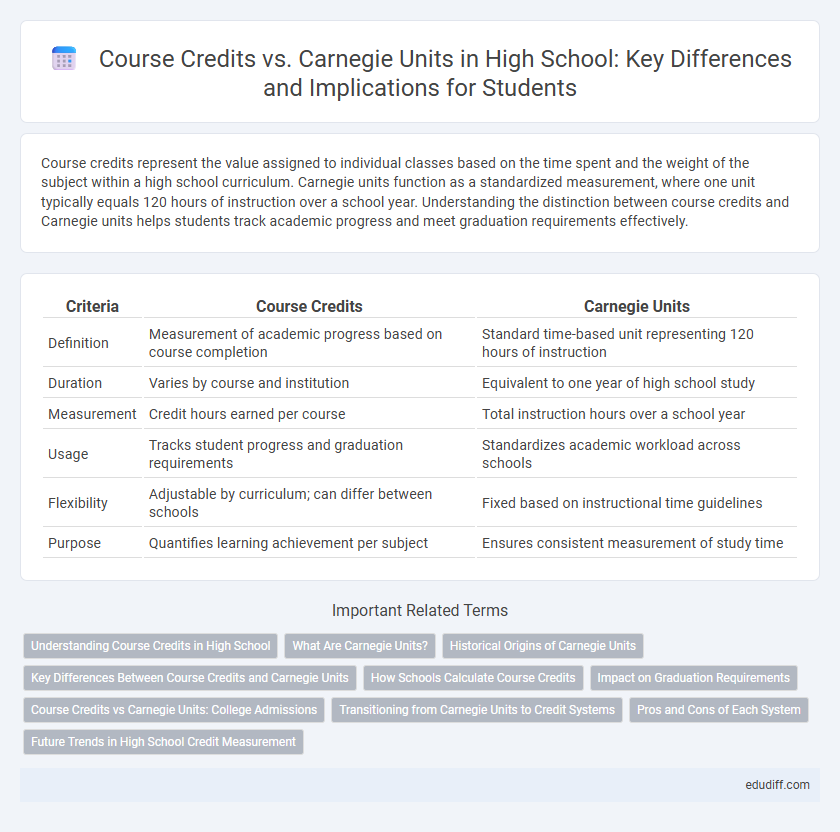Course credits represent the value assigned to individual classes based on the time spent and the weight of the subject within a high school curriculum. Carnegie units function as a standardized measurement, where one unit typically equals 120 hours of instruction over a school year. Understanding the distinction between course credits and Carnegie units helps students track academic progress and meet graduation requirements effectively.
Table of Comparison
| Criteria | Course Credits | Carnegie Units |
|---|---|---|
| Definition | Measurement of academic progress based on course completion | Standard time-based unit representing 120 hours of instruction |
| Duration | Varies by course and institution | Equivalent to one year of high school study |
| Measurement | Credit hours earned per course | Total instruction hours over a school year |
| Usage | Tracks student progress and graduation requirements | Standardizes academic workload across schools |
| Flexibility | Adjustable by curriculum; can differ between schools | Fixed based on instructional time guidelines |
| Purpose | Quantifies learning achievement per subject | Ensures consistent measurement of study time |
Understanding Course Credits in High School
Course credits in high school quantify the amount of time and work a student completes in a specific subject, typically representing one year of study. They differ from Carnegie units, which are a standardized measure of instructional time, usually equivalent to 120 hours of class or laboratory work. Understanding course credits helps students track their academic progress toward graduation requirements efficiently.
What Are Carnegie Units?
Carnegie Units measure the amount of time a student spends in a course, typically equating to 120 hours of instruction, which helps standardize academic credit across high schools. Each Carnegie Unit usually represents one year of study in a subject, aligning with the requirements for earning course credits toward graduation. Understanding Carnegie Units is essential for comparing coursework rigor and meeting state or district graduation criteria.
Historical Origins of Carnegie Units
The Carnegie Unit, developed in the early 20th century by the Carnegie Foundation, standardized high school course credits by measuring the amount of time students spent in class, typically 120 hours per year per subject. This system aimed to create uniformity across schools, enabling consistent evaluation and transfer of student academic progress nationwide. The historical significance of Carnegie Units lies in their foundational role in shaping modern credit systems, providing a quantifiable framework still influencing high school education today.
Key Differences Between Course Credits and Carnegie Units
Course credits represent the value assigned to individual classes students complete, reflecting the time and effort invested in each course, while Carnegie Units quantify the amount of time students spend in class, typically one unit equaling 120 hours of instruction. High schools often use course credits to measure student progress toward graduation requirements, whereas Carnegie Units serve as a standardized metric for instructional time across institutions. Understanding these distinctions helps ensure accurate tracking of academic achievement and compliance with state education standards.
How Schools Calculate Course Credits
Schools calculate course credits by assigning values based on the time spent in class and the instructional hours completed throughout the semester. Unlike Carnegie Units, which represent a standard of 120 hours of instruction per unit, course credits may vary by institution, reflecting different weighting systems for coursework, labs, or advanced classes. This flexibility allows schools to tailor credit requirements to meet state standards and graduation guidelines while accounting for diverse learning experiences.
Impact on Graduation Requirements
Course credits and Carnegie Units serve as measures of academic progress in high school, with each state setting specific requirements for graduation. Carnegie Units typically represent a standardized amount of instructional time, usually one unit equating to 120 hours of class time, which schools convert into course credits for transcript evaluation. The alignment or discrepancy between these measurements directly impacts students' ability to meet graduation criteria, influence course planning, and affect eligibility for advanced diplomas or college admission.
Course Credits vs Carnegie Units: College Admissions
Course credits and Carnegie Units both measure academic progress but differ in application, with course credits representing actual completed courses and Carnegie Units quantifying time spent in instruction. College admissions often evaluate Carnegie Units as a standardized metric to assess whether students meet the minimum credit requirements for graduation, ensuring consistency across high schools. Understanding the distinction helps students tailor their academic plans to fulfill college entrance requirements effectively.
Transitioning from Carnegie Units to Credit Systems
Transitioning from Carnegie Units to course credit systems in high school involves shifting from time-based measurement, traditionally one unit per 120 hours of instruction, to a more flexible credit approach that emphasizes skills and competencies. This change allows for personalized pacing and integration of diverse learning experiences, reflecting a broader understanding of student achievement beyond seat time. Schools adopting credit systems enhance curriculum relevancy and student readiness for postsecondary education by aligning credits with specific learning outcomes.
Pros and Cons of Each System
Course credits offer flexibility by allowing schools to assign varying credit values based on course rigor and duration, promoting personalized learning paths but potentially causing inconsistencies in credit evaluation across institutions. Carnegie Units provide a standardized measurement based on seat time, simplifying credit transfer and graduation requirements while often limiting recognition of alternative learning experiences or varying course intensities. Both systems impact transcript clarity, with Course credits favoring adaptability and Carnegie Units emphasizing uniformity.
Future Trends in High School Credit Measurement
Future trends in high school credit measurement emphasize adaptability beyond traditional Carnegie Units, incorporating competency-based assessments and digital badges to reflect diverse learning achievements. Schools increasingly integrate personalized credit systems aligning with career readiness and college admission standards, supported by data analytics for accurate student progress tracking. Advances in technology and educational frameworks drive a shift towards flexible, skill-oriented credit models promoting equity and lifelong learning pathways.
Course Credits vs Carnegie Units Infographic

 edudiff.com
edudiff.com